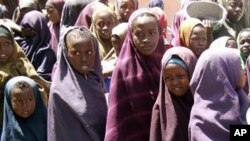The humanitarian group Oxfam says the intensifying drought in Somalia has claimed more than 500 lives and is likely to claim many more.
Hundreds are dead from drought-related disease as Somalia and parts of Kenya and Ethiopia brace for a humanitarian disaster. British-based relief group Oxfam says at least 500 people, including more than 80 children, have died from diseases such as diarrhea since the beginning of the year.
Two seasons of failed rains throughout east Africa have pushed up to 10-million people - including one in three Somalis - toward starvation. Throughout the region, the drought has killed countless crops and hundreds of thousands of livestock, forcing people off their land and into the arid regions of Somalia and Kenya in search of food.
Oxfam spokesperson Alun McDonald says the suffering currently being witnessed may be just the beginning of an even larger crisis.
“It is definitely a big concern that it is going to get worse," said McDonald. "We have just had 12 very, very dry months. We have got at least another three or four dry months before the next rainy season in most of the areas and even that is not guaranteed to come. There is definitely a chance that, over the next few months, we will see much larger-scale loss of life.”
While the food crisis in Somalia has not been designated a famine, many - including the United Nations - believe the situation has reached “pre-famine conditions.” Parts of northern Kenya have received as little as one-quarter of the average yearly rainfall, and analysts say the past year’s rainfall has been the lowest recorded since 1950 and 1951.
The crisis is receiving comparisons to the Somali famine of 1991 and 1992.
“The levels of malnutrition that we are seeing from refugees coming out of Somalia are some of the worst that we have seen since the early 1990s," added McDonald. "People are coming out with malnutrition four or five times the level that is normally considered to be an emergency.”
The 1991-1992 famine claimed more than 300,000 lives before the international community decided to intervene and deliver food. Aid originally sent to alleviate the crisis was being commandeered by Somalia’s warlords to help fuel the country’s civil war.
The ongoing war between Somalia's U.N.-backed Transitional Federal Government and Islamist insurgent group al-Shabab is interfering with aid delivery. The group controls much of southern and central Somalia and has, for the past year, cut off humanitarian access to regions under its control, forcing many to flee.
Equally worrying are the conditions facing refugees pouring into Mogadishu, Kenya and Ethiopia in search of food. While feeding stations have been set up in the Somali capital, the thousands arriving every week have all but overwhelmed the centers. In Kenya, the situation is worse.
According to aid group Save the Children, as many 1,300 Somalis are crossing the Kenyan border each day to seek refuge in the camps at Dadaab. Originally designed to hold around 90,000 people, Dadaab’s three camps are now home to over 360,000, with more coming every day. The new arrivals must battle not only acute malnutrition, but squalid conditions and the threat of disease.
An extension of the facilities at Dadaab has been approved, but delayed for the past year by the Kenyan government. Oxfam's McDonald called for the Kenyan government to allow the camp’s desperately needed expansion. He also criticized the international community for not maintaining the facilities in Dadaab as the population began to mushroom years ago.
Aid Group Appeals for Drought Aid to Somalia














